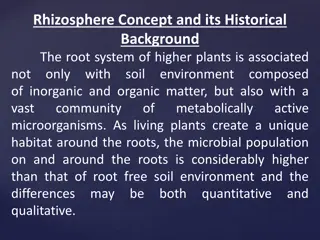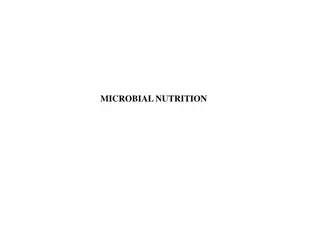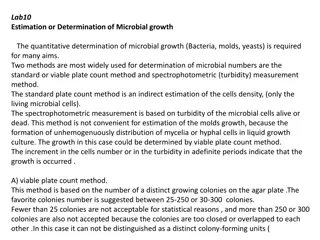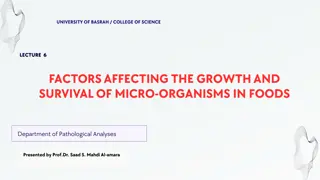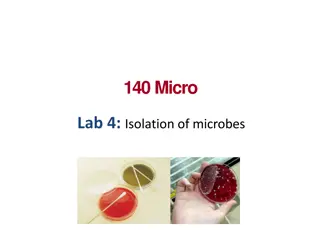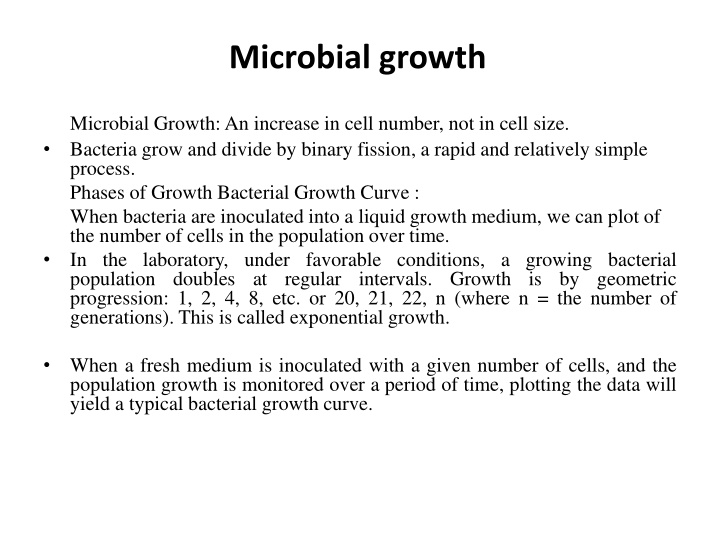
Bacterial Growth Phases and Dynamics
Learn about microbial growth phases including lag, log, stationary, and decline/death phases. Explore the bacterial growth curve in closed systems and the mathematical progression of cell division. Discover the factors influencing microbial growth and the key characteristics of each growth phase.
Download Presentation

Please find below an Image/Link to download the presentation.
The content on the website is provided AS IS for your information and personal use only. It may not be sold, licensed, or shared on other websites without obtaining consent from the author. If you encounter any issues during the download, it is possible that the publisher has removed the file from their server.
You are allowed to download the files provided on this website for personal or commercial use, subject to the condition that they are used lawfully. All files are the property of their respective owners.
The content on the website is provided AS IS for your information and personal use only. It may not be sold, licensed, or shared on other websites without obtaining consent from the author.
E N D
Presentation Transcript
Microbial growth Microbial Growth: An increase in cell number, not in cell size. Bacteria grow and divide by binary fission, a rapid and relatively simple process. Phases of Growth Bacterial Growth Curve : When bacteria are inoculated into a liquid growth medium, we can plot of the number of cells in the population over time. In the laboratory, under favorable conditions, a growing bacterial population doubles at regular intervals. Growth is by geometric progression: 1, 2, 4, 8, etc. or 20, 21, 22, n (where n = the number of generations). This is called exponential growth. When a fresh medium is inoculated with a given number of cells, and the population growth is monitored over a period of time, plotting the data will yield a typical bacterial growth curve.
Four phases of Bacterial Growth LAG PHASE: Period of adjustment to new conditions. No cell division occurs, population size doesn t increase. Phase of intense metabolic activity, in which individual organisms grow in size. There is an increase in total protein, ribonucleic acid and cell phosphorus. May last from one hour to several days.
LOG PHASE: Cells begin to divide and generation time reaches a constant minimum. Cells are smaller in this phase because they are constantly dividing. Cells are at highest metabolic activity Cells are most susceptible to adverse environmental factors at this stage. Radiation Antibiotics
Stationary phase: Population size begins to stabilize. Number of cells produced = Number of cells dying Overall cell number does not increase. Cell division begins to slow down. Factors that slow down microbial growth: Accumulation of toxic waste materials Acidic pH of media Limited nutrients Insufficient oxygen supply
Decline/death phase: Population size begins to decrease. Number of cells dying > Number of cells produced Cell number decreases at a logarithmic rate. Cells lose their ability to divide A few cells may remain alive for a long period of time.
The mathematics of growth When growing exponentially by binary fission, the increase in a bacterial population is by geometric progression. If we start with one cell, when it divides, there are 2 cells in the first generation, 4 cells in the second generation, 8 cells in the third generation, and so on. The generation time is the time interval required for the cells (or population) to divide. G (generation time) = (time, in minutes or hours)/n(number of generations)G = t/n t = time interval in hours or minutes During the exponential phase each microorganism is dividing at constant intervals. Thus the population will double in number during a specific length of time called the generation time or doubling time. Suppose that a culture tube is inoculated with one cell that divides every 20 minutes .The population will be 2 cells after 20 minutes, 4 cells after 40 minutes, and so forth. Because the population is doubling every generation, the increase in population is always 2n where n is the number of generations. The resulting population increase is exponential or logarithmic

